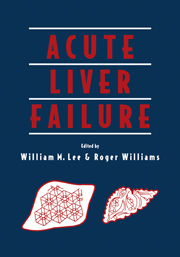Book contents
- Frontmatter
- Contents
- Preface
- Foreword
- Acknowledgments
- Contributors
- Part One Clinical Syndrome and Etiology
- Part Two Mechanisms of Disease and Multisystem Involvement
- Part Three Intensive Care Management
- 10 Medical management of acute liver failure
- 11 Circulatory derangements, monitoring, and management: heart, kidney, and brain
- 12 Brain edema and intracranial hypertension in acute liver failure
- 13 Management of infection in acute liver failure
- Part Four Transplantation
- Part Five Artificial and Bioartificial Liver Devices
- Part Six Other Applications
- Index
- Plate section
13 - Management of infection in acute liver failure
from Part Three - Intensive Care Management
Published online by Cambridge University Press: 20 May 2010
- Frontmatter
- Contents
- Preface
- Foreword
- Acknowledgments
- Contributors
- Part One Clinical Syndrome and Etiology
- Part Two Mechanisms of Disease and Multisystem Involvement
- Part Three Intensive Care Management
- 10 Medical management of acute liver failure
- 11 Circulatory derangements, monitoring, and management: heart, kidney, and brain
- 12 Brain edema and intracranial hypertension in acute liver failure
- 13 Management of infection in acute liver failure
- Part Four Transplantation
- Part Five Artificial and Bioartificial Liver Devices
- Part Six Other Applications
- Index
- Plate section
Summary
INTRODUCTION
Patients with acute liver failure (ALF) require multiple invasive procedures and are at risk of the wide range of nosocomial and opportunistic infections commonly associated with intensive care. Furthermore, these patients are known to have several immunological defects that increase their suspectibility to infection, and are probably more immunocompromised than other groups of susceptible patients such as those with neutropenia. Study of the efficacy of a variety of antimicrobial strategies to reduce the very high infection-related mortality in ALF patients has resulted in the selection of antimicrobial prophylaxis and therapy for these patients. This has been based upon three important factors: knowledge of the immunological abnormalities present in this condition; the risk factors associated with the clinical management of organ failure; and the incidence, timing and microbiological nature of these infections.
NATURE OF DEFECTS IN HOST DEFENSE MECHANISMS
Several defects of host immune function arise as a direct consequence of ALF. The liver is the major site of complement synthesis, and reduced levels of serum complement (mainly C3 and C5 components) are found in ALF (Wyke et al. 1980). Low levels of complement correlate with a low opsonization index against bacteria and yeasts, and opsonization is significantly impaired in both children and adults (Wyke et al. 1980; Larcher et al. 1981; Wyke, Yousif-Kadaru et al. 1982). In addition, serum from these patients is a poor chemoattractant for normal polymorphs.
- Type
- Chapter
- Information
- Acute Liver Failure , pp. 158 - 172Publisher: Cambridge University PressPrint publication year: 1996



